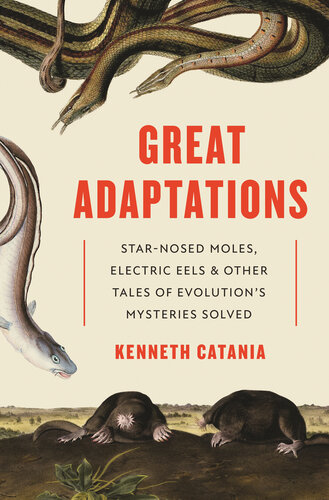
Great Adaptations
Star-Nosed Moles, Electric Eels, and Other Tales of Evolution's Mysteries Solved
کتاب های مرتبط
- اطلاعات
- نقد و بررسی
- دیدگاه کاربران
نقد و بررسی

July 1, 2020
A Vanderbilt biology professor digs into "unsolved biological mysteries and extreme adaptations." What do star-nose moles, electric eels, jewel wasps, tentacled snakes, and water shrews have in common? The rapt gaze of Catania, who investigates those odd creatures and more. The author knows better than most that even animals that have been studied for centuries harbor secrets yet to be uncovered. Using a variety of visual aids to good effect, Catania explores how the humblest species may have developed their remarkable abilities. The author wants us to learn something not only about these extraordinary creatures, but about the process of discovery as well. This begins, prosaically, with the simple act of taking a closer look. A Guggenheim and MacArthur fellow, Catania was motivated to write the book, in part, as an alternative to the necessarily dry technical style of scientific papers, which by their very nature do little to capture the sense of wonder or elation attending new discoveries. It's clear that being a scientist has only magnified the author's sense of wonder, and he notes how chance, failure, an open mind, and tirelessly methodical experimentation are as much natural parts of science as breakthroughs. Very occasionally, he has hit the mother lode in the field, when preparation and a bit of luck intersect with biology, history, and culture, as in the marvel that is earthworm "grunting." His studies also deal with the larger question of the extremes to which evolution can tailor a species to its environment as well as some potentially profound applications: For example, the venom of the jewel wasp, a leading figure in neuroparasitology, "may be useful for research into Parkinson's disease." Perhaps not everyone will share the author's abundant enthusiasm for the specifics of insectivore senses, amphibian electroreceptors, and the vagaries of neuroanatomy, but his delight is contagious. Catania successfully unearths a universe of surprises within a small-scale realm.
COPYRIGHT(2020) Kirkus Reviews, ALL RIGHTS RESERVED.

Starred review from June 22, 2020
By blending accessible writing with cutting-edge science, Catania, professor of neuroscience at Vanderbilt University and a MacArthur Fellowship winner, demonstrates how exciting the process of scientific investigation can be in his invigorating debut. He shares his experiences asking fascinating questions about a number of odd animals including the star-nosed mole, the electric eel, the water shrew, large Florida earthworms, and the emerald jewel wasp. In each case, he describes how his research led to new discoveries, such as how the mole’s nose functions as perhaps the “most sensitive and high-resolution touch system on our planet,” and how the wasp controls the behavior of far larger cockroaches by injecting them with a potent venom. He also explains how his findings may yield insight into other subjects. The wasp venom, for example, may help treat Parkinson’s disease, while the eel’s electrical pulses relate to echolocation in bats, and the mole’s elaborate sense of touch, its primary sense, is surprisingly similar to human vision. Throughout, Catania introduces neuroscience basics in an accessible manner, while also making clear what a large role serendipity can play in scientific investigation. The joy Catania takes in the process of exploring the natural world will delight readers.

Starred review from November 1, 2020
Catania (neurobiology, Vanderbilt Univ.) showcases some strange creatures with unusual capacities. The "star" of his show is the star-nosed mole, with its weird schnoz containing some 25,000 touch-sensitive nerve organs and the ability to gobble small invertebrate prey in world record-breaking time. The mole was undergrad Catania's first real biological assignment; his "strange path of discovery" is brilliantly documented, from figuring how to find and capture his elusive subject to eventually mapping its brain. He also studies tentacled snakes that deploy some devilish hunting strategies, worms that leave the ground in response to "grunts," eels that paralyze their prey with Taser-like jolts, bloodthirsty water shrews, and zombie-making wasps. The author's witty style and amazing findings are complemented by stunning photography and movie shorts that readers with smart phones can scan and play. The astonishing animals are only half the story. Just as compelling is the enquiring-human side--i.e., seeing a scientist at work (and at play), applying a Sherlockian credo: "approach the problem with an open mind, gather every possible clue, start eliminating suspects." VERDICT Casual science readers will be hooked from page one; for those contemplating careers in the sciences, this should be required reading.--Robert Eagan, Windsor P.L., Ont.
Copyright 2020 Library Journal, LLC Used with permission.

























دیدگاه کاربران